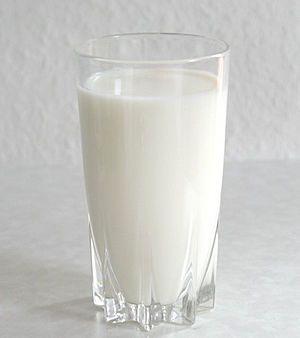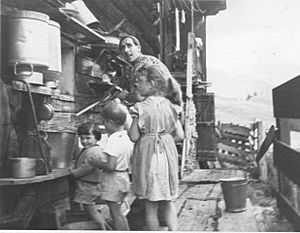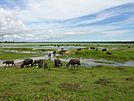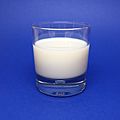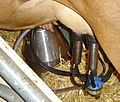Milk facts for kids
Milk is a white liquid made by mammals, for example cows, dogs, and humans. It is made in the mammary glands (breasts, udders, or teats) of female mammals. Because newborn babies have no teeth, they must be given milk before they can eat solid food. Milk has many nutrients to help babies grow and be healthy. It is also a rich source of calcium which is good for your bones and teeth.
Contents
Storing milk
If milk is not kept cold in a refrigerator, it will become sour after some time. When milk is warmed, it turns sour. Fermentation makes this happen. Lactic acid bacteria change the milk sugar into lactic acid. Fermentation is used when making dairy products.
Milk is often pasteurised before humans drink it. It is made into dairy products like cream, butter, yoghurt, ice cream, or cheese. Pasteurised cows' milk will turn sour if it is not kept in a refrigerator. Milk should be stored between 1° and 4° Celsius. If milk is treated with very high temperatures, it will last longer before spoiling. This means it does not have to be put in the refrigerator until it is opened.
Lactose
Milk contains a chemical called lactose. Babies make an enzyme called lactase inside their bodies. Adults make less lactase. If they do not have enough, they may not be able to digest lactose anymore. This problem is called lactose intolerance and it affects many adults. There are many medicines that help adults digest lactose. Many lactose-intolerant people drink soy milk instead of animal milk, because it does not contain lactose. Soy milk tastes similar to animal milk, but it is chemically very different and is made from soybeans.
Types of consumption
Milk consumption occurs in two distinct overall types: a natural source of nutrition for all infant mammals and a food product obtained from other mammals for consumption by humans of all ages.
Nutrition for infant mammals
In almost all mammals, milk is fed to infants through breastfeeding, either directly or by expressing the milk to be stored and consumed later. The early milk from mammals is called colostrum. Colostrum contains antibodies that provide protection to the newborn baby as well as nutrients and growth factors. The makeup of the colostrum and the period of secretion varies from species to species.
For humans, the World Health Organization recommends exclusive breastfeeding for six months and breastfeeding in addition to other food for at least two years. In some cultures it is common to breastfeed children for three to five years, and the period may be longer.
Fresh goats' milk is sometimes substituted for breast milk, which introduces the risk of the child developing electrolyte imbalances, metabolic acidosis, megaloblastic anemia, and a host of allergic reactions.
Food product for humans
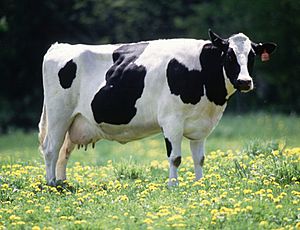
In many cultures, especially in the West, humans continue to consume milk beyond infancy, using the milk of other mammals (especially cattle, goats and sheep) as a food product. Initially, the ability to digest milk was limited to children as adults did not produce lactase, an enzyme necessary for digesting the lactose in milk. People therefore converted milk to curd, cheese and other products to reduce the levels of lactose. Thousands of years ago, a chance mutation spread in human populations in Europe that enabled the production of lactase in adulthood. This mutation allowed milk to be used as a new source of nutrition which could sustain populations when other food sources failed. People process milk into a variety of products such as cream, butter, yogurt, kefir, ice cream, and cheese. Modern industrial processes use milk to produce casein, whey protein, lactose, condensed milk, powdered milk, and many other food-additives and industrial products.
Whole milk, butter and cream have high levels of saturated fat. The sugar lactose is found only in milk, forsythia flowers, and a few tropical shrubs. The enzyme needed to digest lactose, lactase, reaches its highest levels in the human small intestine after birth and then begins a slow decline unless milk is consumed regularly. Those groups who do continue to tolerate milk, however, often have exercised great creativity in using the milk of domesticated ungulates, not only of cattle, but also sheep, goats, yaks, water buffalo, horses, reindeer and camels. India is the largest producer and consumer of cattle and buffalo milk in the world.
| Country | Milk (liters) | Cheese (kg) | Butter (kg) |
|---|---|---|---|
| 135.6 | 6.7 | 2.4 | |
| 127.0 | 22.5 | 4.1 | |
| 105.9 | 10.9 | 3.0 | |
| 105.3 | 11.7 | 4.0 | |
| 90.1 | 19.1 | 1.7 | |
| 78.4 | 12.3 | 2.5 | |
| 75.8 | 15.1 | 2.8 | |
| 62.8 | 17.1 | 3.6 | |
| 55.7 | 3.6 | 0.4 | |
| 55.5 | 26.3 | 7.5 | |
| 54.2 | 21.8 | 2.3 | |
| 51.8 | 22.9 | 5.9 | |
| 49.1 | 23.4 | 0.7 | |
| 47.5 | 19.4 | 3.3 | |
| 39.5 | - | 3.5 | |
| 9.1 | - | 0.1 |
Evolution of lactation
The mammary gland is thought to have derived from apocrine skin glands. It has been suggested that the original function of lactation (milk production) was keeping eggs moist. Much of the argument is based on monotremes (egg-laying mammals). The original adaptive significance of milk secretions may have been nutrition or immunological protection. This secretion gradually became more copious and accrued nutritional complexity over evolutionary time.
Tritylodontid cynodonts seem to have displayed lactation, based on their dental replacement patterns.
History
Humans first learned to consume the milk of other mammals regularly following the domestication of animals during the Neolithic Revolution or the development of agriculture. This development occurred independently in several global locations from as early as 9000–7000 BC in Mesopotamia to 3500–3000 BC in the Americas. People first domesticated the most important dairy animals—cattle, sheep and goats—in Southwest Asia, although domestic cattle had been independently derived from wild aurochs populations several times since. Initially animals were kept for meat, and archaeologist Andrew Sherratt has suggested that dairying, along with the exploitation of domestic animals for hair and labor, began much later in a separate secondary products revolution in the fourth millennium BC. Sherratt's model is not supported by recent findings, based on the analysis of lipid residue in prehistoric pottery, that shows that dairying was practiced in the early phases of agriculture in Southwest Asia, by at least the seventh millennium BC.
From Southwest Asia domestic dairy animals spread to Europe (beginning around 7000 BC but did not reach Britain and Scandinavia until after 4000 BC), and South Asia (7000–5500 BC). The first farmers in central Europe and Britain milked their animals. Pastoral and pastoral nomadic economies, which rely predominantly or exclusively on domestic animals and their products rather than crop farming, were developed as European farmers moved into the Pontic-Caspian steppe in the fourth millennium BC, and subsequently spread across much of the Eurasian steppe. Sheep and goats were introduced to Africa from Southwest Asia, but African cattle may have been independently domesticated around 7000–6000 BC. Camels, domesticated in central Arabia in the fourth millennium BC, have also been used as dairy animals in North Africa and the Arabian Peninsula. The earliest Egyptian records of burn treatments describe burn dressings using milk from mothers of male babies. In the rest of the world (i.e., East and Southeast Asia, the Americas and Australia) milk and dairy products were historically not a large part of the diet, either because they remained populated by hunter-gatherers who did not keep animals or the local agricultural economies did not include domesticated dairy species. Milk consumption became common in these regions comparatively recently, as a consequence of European colonialism and political domination over much of the world in the last 500 years.
In the Middle Ages, milk was called the "virtuous white liquor" because alcoholic beverages were safer to consume than water.
Industrialization
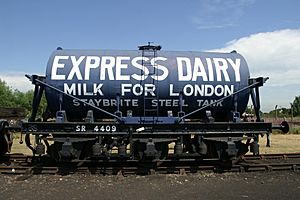
The growth in urban population, coupled with the expansion of the railway network in the mid-19th century, brought about a revolution in milk production and supply. Individual railway firms began transporting milk from rural areas to London from the 1840s and 1850s. Possibly the first such instance was in 1846, when St Thomas's Hospital in Southwark contracted with milk suppliers outside London to ship milk by rail. The Great Western Railway was an early and enthusiastic adopter, and began to transport milk into London from Maidenhead in 1860, despite much criticism. By 1900, the company was transporting over 25 million gallons annually. The milk trade grew slowly through the 1860s, but went through a period of extensive, structural change in the 1870s and 1880s.

Urban demand began to grow, as consumer purchasing power increased and milk became regarded as a required daily commodity. Over the last three decades of the 19th century, demand for milk in most parts of the country doubled, or in some cases, tripled. Legislation in 1875 made the adulteration of milk illegal - this combined with a marketing campaign to change the image of milk. The proportion of rural imports by rail as a percentage of total milk consumption in London grew from under 5% in the 1860s to over 96% by the early 20th century. By that point, the supply system for milk was the most highly organized and integrated of any food product.
The first glass bottle packaging for milk was used in the 1870s. The first company to do so may have been the New York Dairy Company in 1877. The Express Dairy Company in England began glass bottle production in 1880. In 1884, Hervey Thatcher, an American inventor from New York, invented a glass milk bottle, called "Thatcher's Common Sense Milk Jar," which was sealed with a waxed paper disk. Later, in 1932, plastic-coated paper milk cartons were introduced commercially.
In 1863, French chemist and biologist Louis Pasteur invented pasteurization, a method of killing harmful bacteria in beverages and food products. He developed this method while on summer vacation in Arbois, to remedy the frequent acidity of the local wines. He found out experimentally that it is sufficient to heat a young wine to only about 50–60 °C (122–140 °F) for a brief time to kill the microbes, and that the wine could be nevertheless properly aged without sacrificing the final quality. In honor of Pasteur, the process became known as "pasteurization". Pasteurization was originally used as a way of preventing wine and beer from souring. Commercial pasteurizing equipment was produced in Germany in the 1880s, and producers adopted the process in Copenhagen and Stockholm by 1885.
Overproduction
Continued improvements in the efficiency of milk production led to a worldwide glut of milk by 2016. Russia and China became self-sufficient and stopped importing milk. Canada has tried to restrict milk production by forcing new farmers/increased capacity to "buy in" at C$24,000 per cow. Importing milk is prohibited. The European Union theoretically stopped subsidizing dairy farming in 2015. Direct subsidies were replaced by "environmental incentives" which results in the government buying milk when the price falls to €200 per 1,000 liters (220 imp gal; 260 U.S. gal). The United States has a voluntary insurance program that pays farmers depending upon the price of milk and the cost of feed.

The females of all mammal species can by definition produce milk, but cow's milk dominates commercial production. In 2011, FAO estimates 85% of all milk worldwide was produced from cows. Human milk is not produced or distributed industrially or commercially; however, human milk banks collect donated human breastmilk and redistribute it to infants who may benefit from human milk for various reasons (premature neonates, babies with allergies, metabolic diseases, etc.) but who cannot breastfeed.
In the Western world, cow's milk is produced on an industrial scale and is by far the most commonly consumed form of milk. Commercial dairy farming using automated milking equipment produces the vast majority of milk in developed countries. Dairy cattle such as the Holstein have been bred selectively for increased milk production. About 90% of the dairy cows in the United States and 85% in Great Britain are Holsteins. Other dairy cows in the United States include Ayrshire, Brown Swiss, Guernsey, Jersey and Milking Shorthorn (Dairy Shorthorn).
Other animal-based sources
Aside from cattle, many kinds of livestock provide milk used by humans for dairy products. These animals include buffalo, goat, sheep, camel, donkey, horse, reindeer and yak. The first four respectively produced about 11%, 2%, 1.4% and 0.2% of all milk worldwide in 2011.
In Russia and Sweden, small moose dairies also exist.
According to the U.S. National Bison Association, American bison (also called American buffalo) are not milked commercially; however, various sources report cows resulting from cross-breeding bison and domestic cattle are good milk producers, and have been used both during the European settlement of North America and during the development of commercial Beefalo in the 1970s and 1980s.
Swine are almost never milked, even though their milk is similar to cow's milk and perfectly suitable for human consumption. The main reasons for this are that milking a sow's numerous small teats is very cumbersome, and that sows can't store their milk as cows can. A few pig farms do sell pig cheese as a novelty item; these cheeses are exceedingly expensive.
Coconut milk
Coconut milk is not real milk because it comes from a plant instead of an animal. However, it looks similar to real milk because it is white. It also does not have as many nutrients as real milk. It is made by removing the white "meat" from a coconut, pressing or squeezing the "meat", then adding water. It is sometimes used in cooking, for example, in Thai curry. Coconut cream is a thicker version of coconut milk which contains added sugar.
Nutrients
Milk forms an important part of a person's daily balanced diet. It contains a lot of calcium that helps bones and teeth to grow stronger. Also, milk provides the body with high quality proteins, and helps in meeting the body's requirement for vitamins. One glass of milk gives about 44% to the recommended daily vitamins intake. Some kind of milks, though, do not have good calcium. These kind of milk products include cream, cottage cheese, ricotta cheese, and cream cheese.
Images for kids
-
Butterfat is a triglyceride (fat) formed from fatty acids such as myristic, palmitic, and oleic acids.
-
Returning reusable glass milk bottles, used for home delivery service in the UK
-
Vendors in Amritsar,India transporting milk in gagar, 2019
-
Four liter bagged milk in Quebec, Canada
-
A glass bottle of non-homogenized, organic, local milk from the US state of California. American milk bottles are generally rectangular in shape.
-
A rectangular milk jug design used by Costco and Sam's Club stores in the United States which allows for stacking and display of filled containers rather than being shipped to the store in milk crates and manual loading into a freezer display rack
-
Yakult, a probiotic milk-like product made by fermenting a mixture of skimmed milk with a special strain of the bacterium Lactobacillus casei Shirota
-
Gourd used by Kalenjins to prepare a local version of fermented milk called mursik
-
Steamed milk is used in a variety of espresso-based coffee beverages.
See also
 In Spanish: Leche para niños
In Spanish: Leche para niños


